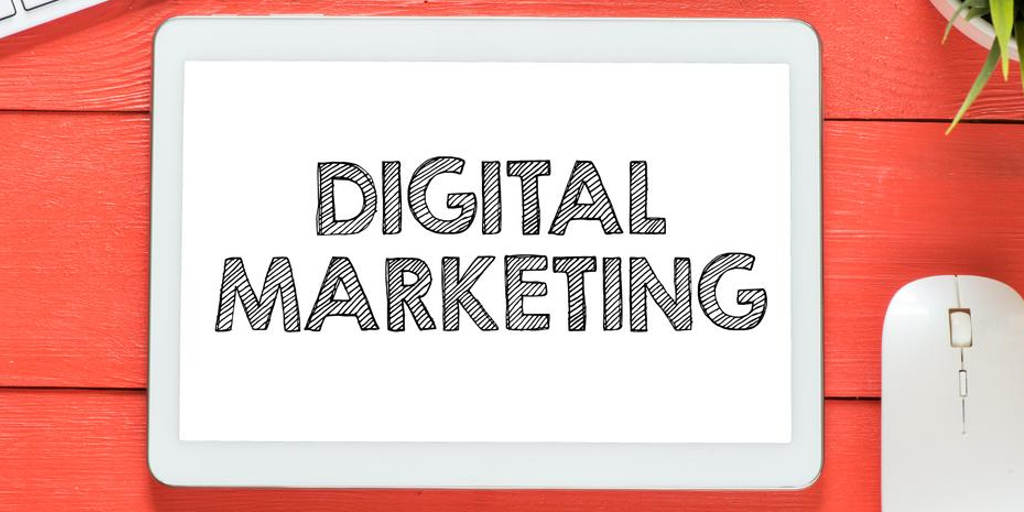Have you heard of digital marketing, but don’t know where to start and aren’t sure what it’s all about? If so, you know all too well how frustrating that can be!
I’m here to help you understand the digital marketing strategies available to you and to make learning about it a lot less confusing.
I am a participant in quite a few affiliate programs that I believe can add value to your business. If you don’t know what that means, you can read more about it in my privacy policy.
Digital marketing isn’t as intimidating as you think or have been led to believe. Best of all? Many of the strategies are easy to do and get started with for free.
In this blog post, I promise I won’t bog you down with industry jargon or complicated terms. Instead, I’ll give you a casual overview of everything related to understanding digital marketing – from the basics and beyond. Let’s get started.
What is Digital Marketing?
Digital marketing is the process of selling products and services through digital channels such as search engines, social media, email, websites and more. It is an umbrella term that covers all forms of online marketing activities.

Digital marketing offers businesses the ability to reach a wider audience quickly and effectively. It can help to improve engagement with customers by providing personalized content that resonates with them.
A digital marketing campaign can offer better, more detailed insights into customer behavior. Businesses can use this valuable data to optimize campaigns for maximum effectiveness and make informed decisions about their products and services.
This information can help inform their overall digital strategy while keeping them up-to-date on industry developments and trends so they can stay competitive in the market.
Different Types of Digital Marketing Strategies
Digital marketing is the use of digital technologies to promote a product or service. It includes all online marketing activities, from search engine optimization (SEO) and content marketing to pay-per-click (PPC) advertising and social media marketing.
Some of the most popular types of digital marketing include:
- Search engine optimization (SEO) to make your website more visible in organic searches on search engines like Google
- Social media marketing, which includes activities like posting on social media platforms like Facebook, Twitter, Instagram etc.
- Pay-per-click (PPC) advertising; email campaigns; mobile app promotion; and online PR.
Each type of digital marketing has its own set of benefits and which one you focus on will depend on your business objectives.
For example, if you want to increase brand awareness or build relationships with customers, then blog content or social media posting might be best. A business looking for an immediate influx of new leads would get better results from PPC.
Search Engine Optimization (SEO)
Search Engine Optimization (SEO) is the process of improving a website’s visibility and ranking in search engines such as Google, Bing, and Yahoo. By optimizing your website for search engines, you can get more organic traffic to your site.

Improving SEO performance is a long game that requires the regular creation of content using specific keywords people are using in the search engines to find you. It also includes making sure your website uses clean code, is hosted on a fast server for fast loading time, and is properly linked to other websites.
You can also use SEO tactics such as link building and optimizing meta descriptions, page titles, headlines, images, and alt tags. All of these elements help improve your website’s overall ability to rank highly in search engine results pages (SERPs).
Content Marketing
Every business with an online presence (and that should be all of them) needs a content marketing strategy creating, publishing, and distributing content related to your business.
Content can include blog posts, articles, videos, webinars, podcasts and social media posts. The goal of content marketing is to attract customers by providing them with valuable information.
Content marketing should not just be used to promote your products or services – it should also be used to educate your audience and help them understand why they need what you are offering.
You can build great relationships with potential customers by establishing yourself as an expert in the industry.
It’s a powerful tool when done correctly as it allows businesses to reach more people and drive more sales and leads for the company through organic search results.
Social Media Marketing
Social media marketing is one of the most popular digital marketing channels, and for good reason. It’s a great way to reach a wide audience and connect with potential customers.
Social media can be used in many ways, from posting regular updates about your company or products to targeting ads to specific people or areas of interest.
You can also engage with customers directly by responding to comments and messages, creating relationships that lead to more sales.
There are an endless number of social media platforms out there, so it’s important to pick the ones that make sense for your business.
Platforms like Facebook, Twitter, Instagram, YouTube and LinkedIn are popular choices among businesses of all sizes due to their wide reach and user base. However, not all platforms suit all audiences, so you may need to experiment for a while to find the platforms that will give you the best results.
Pay Per Click (PPC) Advertising
Pay Per Click (PPC) advertising is a powerful way to drive leads, sales and traffic to your website. It involves running online ads that appear when people type specific search terms into the search engines.
When someone clicks on your ad, you will be charged for the click – hence ‘pay per click’. The amount you pay depends on the specific keyword or phrase used in the ad. This makes it possible to target very specific audiences and get your message out there quickly.
The great thing about PPC advertising is that you only pay when somebody actually clicks on your ad. That means an effective PPC campaign can often cost less than traditional forms of marketing such as radio or print ads because you don’t have to worry about paying for impressions or space in publications that may not generate a return on your investment.
Affiliate Marketing
For certain types of business, like digital products or e-commerce stores, affiliate marketing can be a great way to reach more customers at a low cost.
An affiliate is a person who affiliates with your business by promoting your products to their audience. Unlike traditional sales people, an affiliate only gets paid when they make a sale.
Successful affiliate marketers usually have an established audience who are already interested in the type of products you sell.
Email Marketing
Email marketing is one of the oldest forms of digital marketing, but it still offers the highest return on investment compared to other forms of marketing. According to some sources, returns on email marketing campaigns average out to $40 for every $1 spent.
Email allows you to target specific audiences with tailored messages, and track how those messages perform in terms of clicks, open rates and conversions.
It is important to think about email as more than just promotional emails when creating your content strategy. You can also use email for customer service inquiries, newsletters or announcing new products or services.
Using automated emails that are triggered by certain actions such as signing up for an account or completing a purchase will help your business stay top-of-mind with your customers.
No matter what type of email you’re sending, make sure that the content is interesting and engaging for the reader. Personalize emails whenever possible so that they feel like they’re coming from a friend rather than from a business entity.
Mobile Marketing
Mobile marketing is all about reaching your customers on their phones. It is a great way to reach existing and potential customers, as it allows you to target users based on their age, location, and even device type.
Examples of mobile marketing include sending out text messages with coupons or offers, running display ads on mobile devices, creating mobile-optimized websites that are easily accessible from any smartphone or tablet device, and much more.
Using analytics tools like Google Analytics can help you track the success of your campaigns to make sure they’re delivering the results you need.
Mobile marketing is an essential part of any digital strategy due to its widespread usage and effectiveness in reaching customers on-the-go.
Online PR
Online PR, also known as digital public relations, is the use of online media outlets to reach out and engage with potential customers.
Popular PR platforms include blogs, press releases, social media networks like Twitter or Facebook, and other sources that can help build brand awareness and credibility.
By taking advantage of these channels, you can interact directly with your audience in a more personalized way than traditional advertising does. You can also get direct feedback from readers that will help you improve your products or services for better customer satisfaction.
Plus, by building relationships with influencers in your niche through online PR strategies such as guest blogging opportunities or link building campaigns, can improve your backlink profile over time.
Benefits of Digital Marketing
Digital marketing is one of the most efficient and cost-effective ways to reach your target audience. It provides a unique opportunity for businesses to promote their services and products on multiple channels, and can help them achieve better results.

Thanks to digital marketing, businesses can track the performance of their campaigns in real time and make adjustments whenever needed.
This helps ensure that companies are getting the maximum return for each dollar spent. Also, digital marketing strategies often have very low overhead costs compared to traditional methods such as print advertising or TV commercials.
Digital marketing offers near real time interaction with your audience, which is great for developing lasting relationships. You can also strengthen trust and improve your authority by providing valuable content they can use in their daily lives.
How to Get Started with Digital Marketing
It’s not hard to get started with digital marketing, but it requires dedication and a willingness to learn. It also takes time to see results, so be prepared for that (unless you are using PPC, that is).
The first step is to define your goals. What do you want to achieve? Is it more traffic, more sales, or something else? Knowing what your goals are will help shape the strategy and tactics you use.
Second, choose the channels where you want to focus your efforts. Common channels for digital marketing include SEO (search engine optimization), content marketing, social media, email marketing and PPC (pay-per-click) advertising.
You don’t have to use all of them; just focus on one or two that fit best with your business objectives. I recommend developing your experience in just one or two digital marketing fields before moving on to the next.
Thirdly and most importantly – create quality content! This is an important part of digital marketing success, because it keeps customers coming back for more, and it’s how people find your business in the first place.
Content can come in many forms such as blogs posts, videos or webinars – whatever works best for you!
Finally, look at your campaign results and adjust over time – what works today may not work tomorrow, so be ready to adapt quickly.
Define Your Goals
Before you get started with digital marketing, it’s important to define your goals. Setting clear goals will help you focus on the right activities and see results quicker.

Start by asking yourself some questions: What is the purpose of this campaign? Do I want to grow brand awareness or generate more leads? Who am I targeting? How much time and budget do I have to dedicate towards this project?
Once you know what your business’s most important goals are, you can start to develop an effective strategy that will help you achieve them. Not only does having well-defined goals make it easier for successful execution, but it also helps keep everyone in sync about why certain decisions are being made throughout the campaign process.
Choose Your Channels
When you have some understanding about the different types of digital marketing channels and how they can help you achieve your goals, you can start to figure out what works best for you.
Different channels may have different levels of effectiveness depending on your target audience, the type of content that works for them, and other factors.
There are plenty of options out there: social media platforms such as Facebook, Instagram, Twitter and LinkedIn; search engine optimization (SEO) through Google Ads or Bing Ads; affiliate programs; online PR activities such as influencer outreach and press releases; mobile apps and more.
Consider what kind of content will suit each channel best – is it text-heavy? Is it visual? Will it require paid promotion? Researching these questions ahead of time can save a lot of future headaches!
Create Quality Content
Content is the cornerstone of every digital marketing campaign. If you want your efforts to be successful, then you need to create quality content that resonates with your target audience.
Quality content is engaging, informative and valuable for those who consume it. It should also be search engine optimized so that potential customers can easily find it when searching for your products or services online.
Creating quality content means understanding the needs of your customers and tailoring your messaging accordingly. You have to know what questions they have, which pain points you can solve and how best to present solutions in an easy-to-understand format. Every piece of published content should also include visuals like images, videos and infographics to make it easy to understand and absorb the information.
Analyze Your Results
Once you have launched your digital marketing campaigns, it’s time to measure their performance. Results-oriented marketers know that analysis and optimization are essential components of any successful strategy.
Analyzing the data from your campaigns can help you identify which strategies are most effective, as well as uncover opportunities for improvement.
To make sure you’re getting the most out of your efforts, start by setting up tracking tags to collect valuable data such as conversions, cost per acquisition, and cost per click.
Also, be sure to monitor metrics like click-through rates (CTR), pages visited per session, and average time on site. These will tell you how engaged users are with your content or ads.
Once you’ve collected this data, use it to refine and optimize future campaigns based on what works best for your target audience. With careful analysis and optimization practices in place, you’ll be well on your way towards creating an effective digital marketing strategy!
Digital marketing is an important part of running a successful business in today’s world, and understanding it can help you make your business more successful.

Always keep in mind that digital marketing is a constantly evolving field. Staying up-to-date with the latest trends and strategies is key if you want to get the most out of your efforts.
The most important thing for digital marketing is to know what works for you and your business. Different companies have different needs, and finding the right combination of tools, platforms, channels and techniques will require some trial and error.
So, keep learning about digital marketing, test new ideas and see what works best for you!
